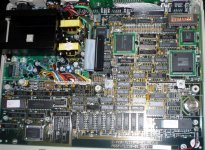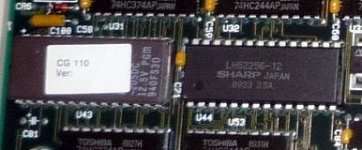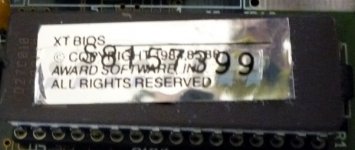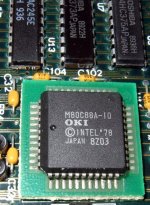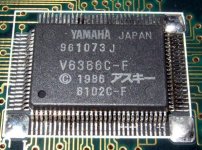Hi,
As per this thread, I've been trying to gain access to the 'expended' (as the BIOS calls it) 128KB RAM to use as a RAM disk.
SI from Norton 4.5 shows 128KB of extended RAM at 10000-12000. No other memory tool that'll run on this machine sees it, and I can't run himem.sys on an 8088, but vdisk.sys from DR-DOS can find it and use it as a RAM drive. I can write to the drive and read back what I've written, but after a minute or so the contents get corrupted.
I'm pretty sure this is due to that 128KB sharing address space with the 128KB DR-DOS ROM disk that's embedded in this machine, which it will boot from by default. Since DR-DOS 3.41 is not much use to me and I have bootable floppies (this machine has no hard drive), I'd like to disable the ROM disk and use the 128KB as a RAM disk.
There are three ROM chips on the board. One is the Award BIOS and is removable. The other two are not removable, shown in the photo with white stickers on them. I don't want to damage either of these irreparably, so I'd like to identify the Vcc line and carefully snip it. Does anyone have any idea which chip that would be, and which leg(s)?
As per this thread, I've been trying to gain access to the 'expended' (as the BIOS calls it) 128KB RAM to use as a RAM disk.
SI from Norton 4.5 shows 128KB of extended RAM at 10000-12000. No other memory tool that'll run on this machine sees it, and I can't run himem.sys on an 8088, but vdisk.sys from DR-DOS can find it and use it as a RAM drive. I can write to the drive and read back what I've written, but after a minute or so the contents get corrupted.
I'm pretty sure this is due to that 128KB sharing address space with the 128KB DR-DOS ROM disk that's embedded in this machine, which it will boot from by default. Since DR-DOS 3.41 is not much use to me and I have bootable floppies (this machine has no hard drive), I'd like to disable the ROM disk and use the 128KB as a RAM disk.
There are three ROM chips on the board. One is the Award BIOS and is removable. The other two are not removable, shown in the photo with white stickers on them. I don't want to damage either of these irreparably, so I'd like to identify the Vcc line and carefully snip it. Does anyone have any idea which chip that would be, and which leg(s)?

